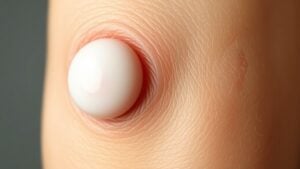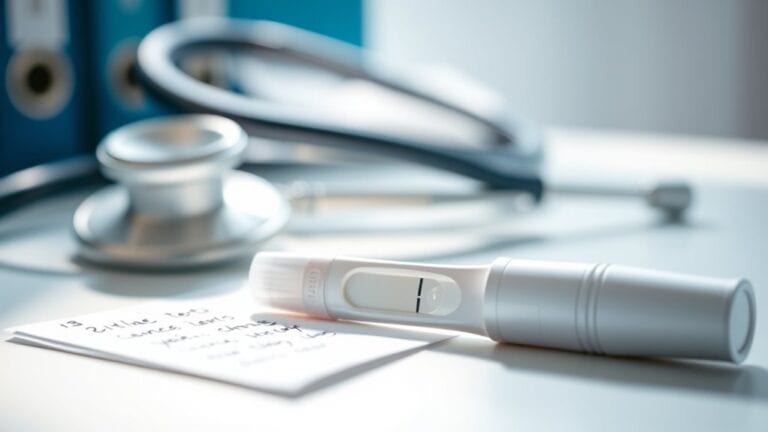Should you’ve noticed a lump on your penis, it’s natural to feel concerned. Sebaceous cysts are common and usually harmless, but comprehending what causes them can ease your mind. These lumps often come from blocked sebaceous glands and can be linked to factors like skin trauma, hormonal shifts, or even genetics. Being aware of the symptoms and how to address them is essential for your peace of mind. Curious about what to look for and the next steps?
What Is a Sebaceous Cyst on the Penis?
A sebaceous cyst on the penis can sound alarming, but it’s quite a common and benign condition that many people experience. These cysts form whenever sebaceous glands become blocked, creating small, firm lumps on the skin. They typically match your skin’s color and texture and are often painless or cause minimal tenderness.
Though sebaceous cysts are benign, they can sometimes become inflamed or infected, leading to discomfort. Maintaining good hygiene can help reduce the risk of developing these lumps.
In case a cyst causes you psychological distress or significant irritation, surgical excision is a treatment option, but keep in mind, many of these cysts resolve on their own without intervention.
Common Causes of Sebaceous Cysts
Sebaceous cysts on the penis can develop for various reasons, often stemming from the blockage of sebaceous glands that leads to a buildup of sebum beneath the skin.
Hormonal changes during puberty can also be a cause, as they increase oil production in your skin. Should you have a family history of cysts, you could be more prone to develop them, too.
Skin irritation or injury, like from shaving, is another common trigger. Poor hygiene can also play a role; whenever you don’t practice good hygiene, oil and debris can accumulate in hair follicles or glands.
Comprehending these causes can help you recognize this condition and investigate potential treatments effectively.
Symptoms of a Sebaceous Cyst
Upon noticing a firm, painless lump on the penis, it’s natural to feel a bit concerned. These lumps are often sebaceous cysts, typically skin-colored or with slight discoloration, and they don’t usually change in size.
While most sebaceous cysts remain painless, they can become inflamed and tender should an infection occur, leading to symptoms such as redness, swelling, and pus discharge. You may even spot keratin material on the surface, resembling a small blackhead.
Recall, these cysts usually appear as solitary lumps, not in clusters like sexually transmitted disease-related bumps. While the symptoms are often mild, it’s crucial to monitor any changes to guarantee your health and peace of mind.
Diagnosis and Tests for Sebaceous Cysts
Upon noticing a lump on your penis, it’s natural to feel concerned and seek answers.
A healthcare provider will likely start with a physical examination to assess the cyst’s characteristics.
Should it be necessary, they may order tests to guarantee everything’s in the clear, helping to rule out other conditions like STDs.
Physical Examination Process
Though finding a lump on your penis can feel alarming, grasping the physical examination process can ease your worries.
During this examination, your healthcare provider will focus on comprehending the characteristics of the sebaceous cysts, looking at their appearance, size, firmness, and color. They might check whether the cyst is tender or painful.
It’s essential to differentiate these cysts from bumps caused by sexually transmitted diseases, which is often achieved through careful visual inspection and palpation.
Should there be any concern, possibly due to the clinical presentation, a biopsy could be necessary to rule out conditions like penile cancer.
In some cases, urinalyses or cultures might also take place to guarantee a comprehensive evaluation should any other symptoms appear.
Diagnostic Testing Methods
After comprehending the physical examination process, you’ll feel more at ease with the next steps in diagnosing sebaceous cysts on the penis.
Diagnosing these cysts typically starts with a visual assessment from your healthcare provider. They’ll check the cyst’s size and characteristics during the physical examination.
Should there be concerns about sexually transmitted diseases (STDs), they might suggest urinalyses or blood tests. In the event that infection is a possibility, fluid cultures from the cyst help direct the right antibiotic treatment.
In uncertain cases, a biopsy could rule out conditions like penile cancer, especially when the cyst appears unusual.
It’s crucial to distinguish between cysts and other lesions, as cysts are generally firm, painless, and distinctive.
Treatment Options for Sebaceous Cysts
Upon addressing sebaceous cysts on your penis, you’ve got a few solid options to evaluate.
Surgical excision is often the go-to method, especially in the event the cysts cause discomfort or concern.
Should you be managing an infection, your doctor may prescribe antibiotics, while home care strategies like warm compresses can help ease any tenderness you may experience.
Surgical Excision Procedures
Surgical excision stands out as the go-to treatment for sebaceous cysts on the penis, especially in case these bumps make you uncomfortable or raise concerns about their appearance.
It’s the primary treatment option, typically performed under local anesthesia to keep you comfortable. During the procedure, a small incision is made to guarantee complete cyst removal, effectively reducing the chance of recurrence.
Post-operative care is vital; you’ll need to change dressings daily, maintain hygiene, and steer clear of water immersion or sexual activity while healing.
Should the cyst be asymptomatic and doesn’t present a medical concern, surgical excision may not be necessary.
However, it’s a reliable way to address these cysts whenever they do affect your confidence or comfort.
Antibiotics for Infections
As you maneuver through the sometimes tricky terrain of sebaceous cysts, it’s essential to know that infections can complicate matters, often causing unwelcome symptoms like pain and redness.
Should your cyst become infected, antibiotics may be prescribed to tackle the inflammation and eliminate the bacteria causing the infection. Common choices include doxycycline and cephalexin. These antibiotics help reduce swelling and prevent further complications.
However, it’s vital to follow your healthcare provider’s instructions and complete the full course of medication. Keep in mind, while antibiotics can treat the infection, they won’t remove the cyst itself.
In the event the cyst persists after treatment, you could still need surgical excision to resolve the issue completely.
Always seek medical advice customized to your specific situation.
Home Care Strategies
Managing a sebaceous cyst, especially in sensitive areas like the penis, can feel overwhelming, but with the right home care strategies, you can find comfort and promote healing.
Here are some effective tips:
- Keep the area clean and dry to minimize infection risk.
- Apply a warm compress for 10-15 minutes to reduce discomfort and encourage healing.
- Resist the urge for self-removal or squeezing, as it could lead to complications.
- Should you notice signs of infection, consult a healthcare provider for possible antibiotic treatment.
- Consider discussing surgical excision with a doctor should the cyst be bothersome or recurrent.
Prevention and Care for Sebaceous Cysts
At the time you take steps to care for your genital area, you’re not just promoting hygiene—you’re also helping to prevent sebaceous cysts on the penis.
Start with regular washing and drying of the area to keep it clean and minimize oil buildup. Consider wearing loose-fitting clothing to reduce friction and skin irritation that could lead to cyst formation.
Regularly wash and dry your genital area to maintain cleanliness and prevent oil buildup, and choose loose-fitting clothing to minimize irritation.
As it pertains to grooming, avoid using razor blades, as they can irritate delicate skin. Regularly monitor your skin for any changes or new lesions, as prompt identification can encourage a timely medical consultation.
Finally, opt for non-comedogenic products to lessen oil accumulation and further protect your skin from sebaceous cysts.





